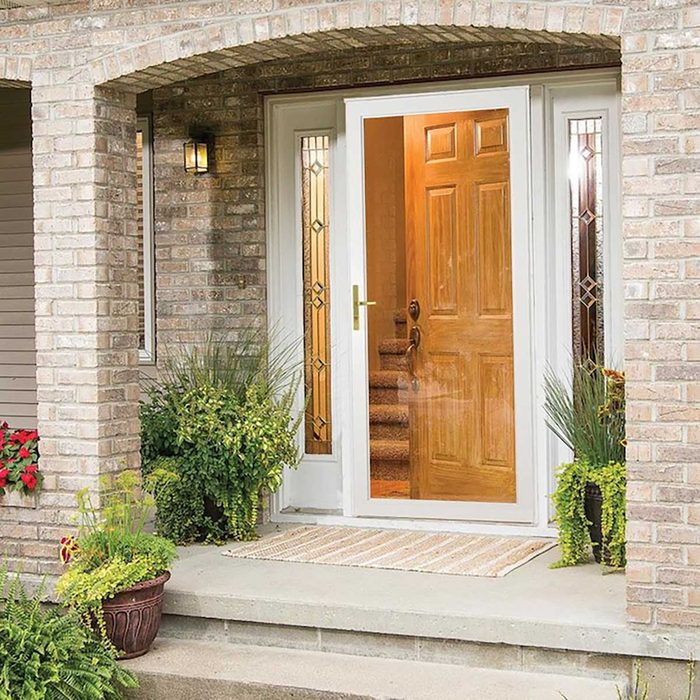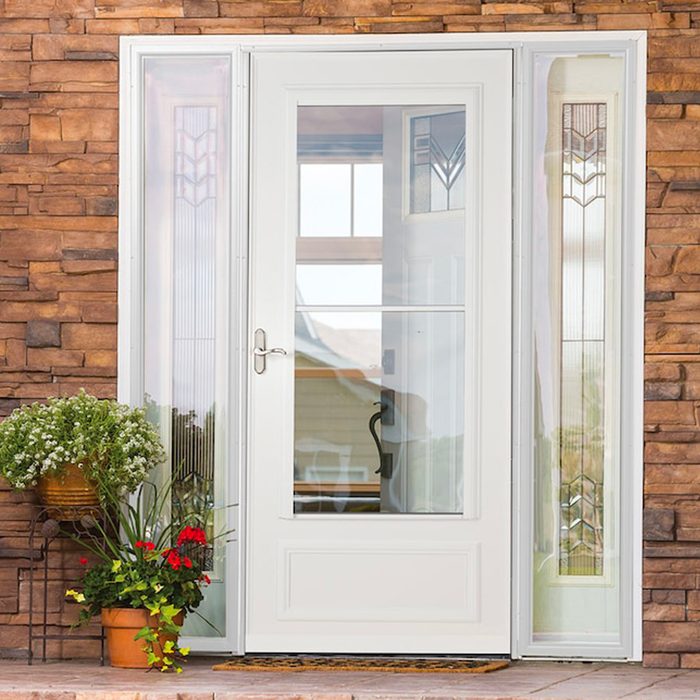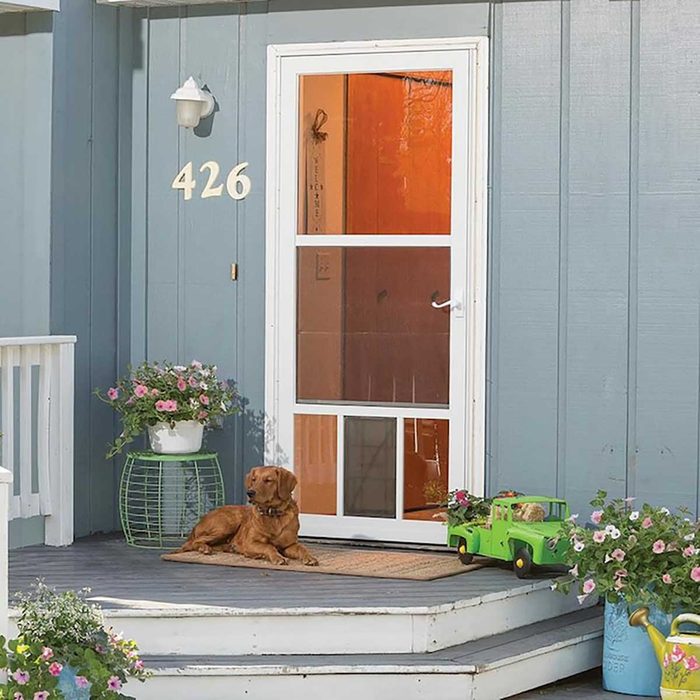4
/
4
via merchant
via merchant
Pros:
-
Flexible pet flap
-
Tear-resistant screen
-
Offers top and bottom ventilation
-
Universal hinge
-
Includes handle
Cons:
-
Not ideal for pets more than 100 pounds
A storm door can do double-duty as a pet door. We think this pet view storm door from Larson is the best option if you own a pet who’s allowed outdoors on their own. The full-view door is divided into three panels, including a screen that you can position at the top or the middle of the door. The 10-inch by 17-inch flap accommodates pets up to 100 pounds, and you can close it off when you want to keep your pet inside.
What to Consider When Buying a Storm Door
When selecting a storm door, it’s important to examine energy efficiency, curb appeal factors, ease of installation, material and security. “It’s essential to consider various factors to ensure your storm door meets both functional and aesthetic needs,” says Jeramy Sibley, President of Glass Doctor, a glass repair, replacement and installation company. “Aesthetics are crucial to enhance curb appeal and should align with your home’s architectural style and color scheme. Lifestyle considerations, such as the presence of pets or children, influence the choice between durable screens and full-view options.”
- Style: The three basic storm door styles are full-view, ventilating and retractable.
- Full View Storm Doors: This type of storm door has a complete glass panel allowing a full view of the outside. “If desired, the glass can be replaced with a screen, requiring proper storage of the glass panel,” says Sibley.
- Ventilating Storm Doors: A ventilating storm door has two glass panels alongside one or two screen panels. The panels can be adjusted vertically to reveal the screen panel, allowing a section of the door to be ventilated. There’s no need to fully remove the glass to swap it out with a screen like full-view storm doors.
- Retractable or Roller Screen Storm Doors: This type of storm door has a full glass panel or view and a hidden screen that can be pulled down for privacy or shade. “This screen operates from a tensioned dowel housed at the top of the storm door,” says Sibley. “A retractable or roll screen door offers the combined benefits of both the full-view storm door and the ventilating storm door.”
- Material and Durability: Chances are, your storm door will be exposed to the elements, so a durable material is a must. The material and durability directly impact the door’s longevity. Storm doors are made from aluminum, steel or fiberglass. All three materials are durable and require very little maintenance. Your selected material comes down to budget, style and the abundance of the material in your area.
- Energy Efficiency: Storm doors greatly increase your home’s energy efficiency, especially if your main door is older or poorly sealed. “Investing in storm doors is important, particularly for homes with older, poorly sealed doors, as they can enhance energy efficiency, especially during extreme weather conditions,” says Sibley. “Additionally, the screens in storm doors provide ventilation, which is beneficial in homes without air conditioning during the summer, allowing fresh air while minimizing the entry of unwanted insects.”
- Security: Storm doors provide an extra layer of security to your home. It’s another door for potential thieves to get through; some come with a deadbolt or the option to install one. However, since most storm doors contain glass or a screen, it’s not difficult to break through. If security is a big concern, look for a security-specific door option.
- Ventilation Options: Storm doors can be fitted with glass, a screen or both. Think about what option will be best for the climate you live in and the look you’re going for.
- Cost: “The cost to install a storm door can vary widely depending on several factors such as the type of door, material, brand and whether professional installation is required,” says Sibley. “On average, the cost of a basic storm door can range from $200 to more than $500. Prices may vary based on location, specific product choices and installation requirements.” It’s always a good idea to get a few different quotes from local suppliers and contractors before deciding on the best option for you.
How We Found the Best Storm Doors
We selected the best storm doors based on high user reviews, ease of installation and special features like curb appeal and pet-view doors. We gave high marks to bestsellers in their category and options with multiple finishes available.
ⓘ
FAQs
What is the best material for a storm door?
The best material for a storm door depends on preferences and needs. Steel provides strength and security but may require maintenance to prevent rust. Aluminum is durable, lightweight and corrosion-resistant, requiring less upkeep. Ultimately, the best material for a storm door depends on individual preferences, budget and climate.
What is a storm door?
A storm door is an additional door installed in front of an existing exterior door. Its purpose is to provide extra protection against harsh weather conditions, while still allowing natural light and ventilation into the home. These doors can also help improve security, as well as block cold drafts by adding a layer of insulation.
Which is better storm door or security door?
Choosing between a storm door and a security door depends on your priorities. A storm door focuses on weather protection and ventilation, with options for glass and screens. Meanwhile, a security door prioritizes safety, featuring heavy-duty materials and reinforced locks to deter break-ins. If you want both weather resistance and enhanced security, some doors offer a combination of features.
How do you install storm doors?
If you have decent DIY skills and the right tools, you can install a storm door yourself. You’ll need a drill, a Phillips head screwdriver, measuring tape, a level, an angle tool, scissors and safety goggles. Most storm doors are pre-hung on a frame and come with an installation kit that includes all the hardware you need. Specific steps may vary, so it’s crucial to follow the provided instructions.


























